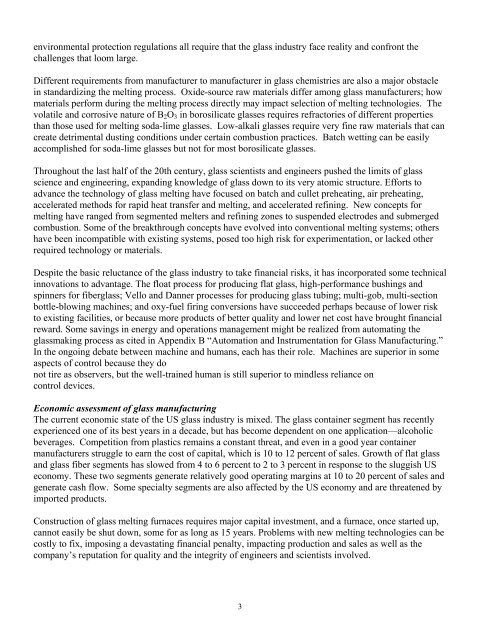Glass Melting Technology: A Technical and Economic ... - OSTI
Glass Melting Technology: A Technical and Economic ... - OSTI
Glass Melting Technology: A Technical and Economic ... - OSTI
Create successful ePaper yourself
Turn your PDF publications into a flip-book with our unique Google optimized e-Paper software.
environmental protection regulations all require that the glass industry face reality <strong>and</strong> confront the<br />
challenges that loom large.<br />
Different requirements from manufacturer to manufacturer in glass chemistries are also a major obstacle<br />
in st<strong>and</strong>ardizing the melting process. Oxide-source raw materials differ among glass manufacturers; how<br />
materials perform during the melting process directly may impact selection of melting technologies. The<br />
volatile <strong>and</strong> corrosive nature of B2O3 in borosilicate glasses requires refractories of different properties<br />
than those used for melting soda-lime glasses. Low-alkali glasses require very fine raw materials that can<br />
create detrimental dusting conditions under certain combustion practices. Batch wetting can be easily<br />
accomplished for soda-lime glasses but not for most borosilicate glasses.<br />
Throughout the last half of the 20th century, glass scientists <strong>and</strong> engineers pushed the limits of glass<br />
science <strong>and</strong> engineering, exp<strong>and</strong>ing knowledge of glass down to its very atomic structure. Efforts to<br />
advance the technology of glass melting have focused on batch <strong>and</strong> cullet preheating, air preheating,<br />
accelerated methods for rapid heat transfer <strong>and</strong> melting, <strong>and</strong> accelerated refining. New concepts for<br />
melting have ranged from segmented melters <strong>and</strong> refining zones to suspended electrodes <strong>and</strong> submerged<br />
combustion. Some of the breakthrough concepts have evolved into conventional melting systems; others<br />
have been incompatible with existing systems, posed too high risk for experimentation, or lacked other<br />
required technology or materials.<br />
Despite the basic reluctance of the glass industry to take financial risks, it has incorporated some technical<br />
innovations to advantage. The float process for producing flat glass, high-performance bushings <strong>and</strong><br />
spinners for fiberglass; Vello <strong>and</strong> Danner processes for producing glass tubing; multi-gob, multi-section<br />
bottle-blowing machines; <strong>and</strong> oxy-fuel firing conversions have succeeded perhaps because of lower risk<br />
to existing facilities, or because more products of better quality <strong>and</strong> lower net cost have brought financial<br />
reward. Some savings in energy <strong>and</strong> operations management might be realized from automating the<br />
glassmaking process as cited in Appendix B “Automation <strong>and</strong> Instrumentation for <strong>Glass</strong> Manufacturing.”<br />
In the ongoing debate between machine <strong>and</strong> humans, each has their role. Machines are superior in some<br />
aspects of control because they do<br />
not tire as observers, but the well-trained human is still superior to mindless reliance on<br />
control devices.<br />
<strong>Economic</strong> assessment of glass manufacturing<br />
The current economic state of the US glass industry is mixed. The glass container segment has recently<br />
experienced one of its best years in a decade, but has become dependent on one application—alcoholic<br />
beverages. Competition from plastics remains a constant threat, <strong>and</strong> even in a good year container<br />
manufacturers struggle to earn the cost of capital, which is 10 to 12 percent of sales. Growth of flat glass<br />
<strong>and</strong> glass fiber segments has slowed from 4 to 6 percent to 2 to 3 percent in response to the sluggish US<br />
economy. These two segments generate relatively good operating margins at 10 to 20 percent of sales <strong>and</strong><br />
generate cash flow. Some specialty segments are also affected by the US economy <strong>and</strong> are threatened by<br />
imported products.<br />
Construction of glass melting furnaces requires major capital investment, <strong>and</strong> a furnace, once started up,<br />
cannot easily be shut down, some for as long as 15 years. Problems with new melting technologies can be<br />
costly to fix, imposing a devastating financial penalty, impacting production <strong>and</strong> sales as well as the<br />
company’s reputation for quality <strong>and</strong> the integrity of engineers <strong>and</strong> scientists involved.<br />
3

















